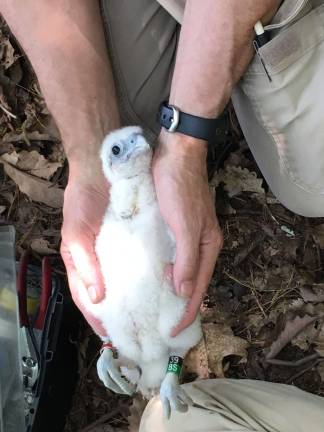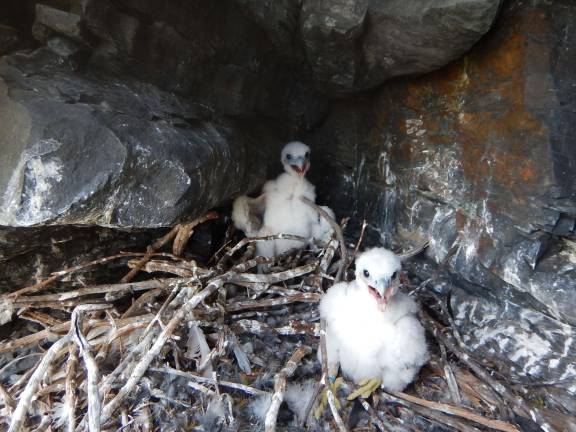Peregrine falcon chicks return to Milford cliffs after 70-year absence


BUSHKILL — After a 70-year absence, peregrine falcons have successfully nested this year in the Milford Cliffs area of the Delaware Water Gap National Recreation Area.
Historic nesting pairs were first reported on these cliffs in the 1940s and 1950s. No nests have been identified at this site until now, says the National Park Service.
Declines of nesting peregrine falcons in the northeastern United States were first observed following World War II and the use of the pesticide DDT. The catastrophic decline led to their federal listing as endangered by the U.S. Fish and Wildlife Service in 1972. Once a federally listed endangered species, peregrines were delisted in 1999 because of their highly successful recovery in many places in North America. The species remains listed as an endangered species in the state of Pennsylvania and is a protected species in the park.
The number of known cliff-nesting pairs in the state is 12. The park now has two.
Thanks to the cooperative efforts of park staff, Pennsylvania Game Commission staff, and volunteers, the nest has been monitored closely over the past several months following reports of territorial behaviors initially seen along the cliffs in February. In March the pair selected a nesting site on those same craggy, shale cliffs and then proceeded to lay eggs. Later in the spring adult brooding and feeding behaviors were observed, indicating that the eggs hatched.
To track chicks after they fledge and disperse Pennsylvania Game Commission staff, park staff, and volunteers worked together to locate the nest and band the two chicks. During the banding process each chick was assessed to determine gender, size, and health. One leg was banded with large letter and number combinations that can be seen with binoculars. The other leg was banded with a uniquely numbered silver band tracked by state and federal agencies.
Biologists will continue to closely monitor the chicks over the next several weeks. The park service asks that visitors honor the marked closures, since disturbing the young birds could result in a premature exit from the ledge before they have learned to fly. Closed areas will reopen when the young birds are old enough to not be disturbed by human activity. This is expected in late July or early August, once the young fledge from the nest.